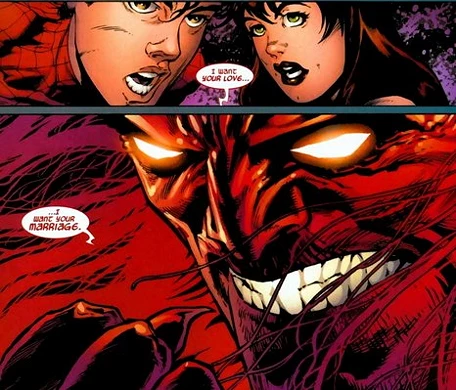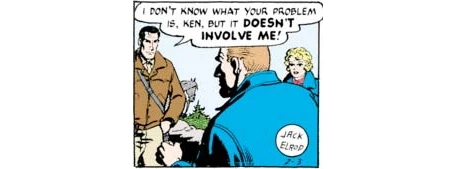
The 15 Worst Comics of the Decade, Part 2
ComicsAlliance's 15 Worst Comics of the Decade continues!
Spider-Man: Sins Past (2004-2005)

What did Spider-Man fans ever do to J. Michael Stracynski, Mike Deodato Jr. and Marvel Comics to merit the anguish that was "Sins Past?" Looking back, it reads almost like a mashup of every bad idea in comics' storied history, as though JMS were dared to write the worst story ever just to spite Internet trolls and kept declining until he got, like, triple dog dared and finally gave in.
Remember the devastasting moment when the Green Goblin tossed Spider-Man's great love Gwen Stacy off a bridge and killed her? Well, it turns it he only did it because she was his (the Green Goblin's!) illegitimate baby mamma. For real – even though Gwen and Peter Parker never got past old-fashioned hand holding, the beautiful, intelligent Gwen decided to go all the way with her friend's mean, creepy dad, and got totally knocked up -- all unbeknownst to Peter.
So Gwen ended up giving birth to twins. Norman secretly raised them in Paris after her death, telling them that Peter was their father andwais responsible for the death of their mother, all in a bid to one day use them against Spider-Man. Then the kids are magically hyper-aged, just because, and they decide it would be awesome to travel to America and kill their deadbeat dad. Because they were raised to believe their pops was Peter, right? But it's totally Osborn!
The boy twin who looks like Osborn becomes the Grey Goblin and keeps trying to kill Peter, while his sister who looks like a hot, young Gwen tries to sleep with the guy she thinks is her father – and he considers it! In the end there's amnesia and craziness and the twins escape into the night... most readers just wanted it over with by then. Anyway, they're probably working in a hostel and going to trance shows now. Point is, aside from Osborn's pregnant Gwen hallucination in "Mighty Avengers," nobody has mentioned this disaster in years.
The worst part of the whole story is that when Peter tries to talk to his wife about the baby mama drama, Mary Jane confesses that she'd known about it for years. Are you still mad Peter sold that marriage to the devil?
As an artist, Deodato Jr.'s hands are clean when it comes to the horrific events of the story, but there's no arguing that his realistic linework served as a magnifying glass to the slash-fiction horror that is imagining Norman Osborn in flagrante delicto.

The reason the storyline is so hard to swallow isn't just because it's insane – comic readers like insane – it's because it seemed genuinely demented. JMS was a creator most readers had learned to trust from a young age. His stints on "He-Man and the Masters of the Universe" and "The Real Ghostbusters," followed by his work on "Babylon 5," "Rising Stars" and his first year on Spidey were relatively beloved.
Now fans can't pick up a copy of "Thor" or "The Brave and the Bold" without the looming feeling that it could blow up in their hands. It's the Roman Candle effect – totally fun until you're being treated for facial burns. To be fair, JMS didn't dig the story either and wanted it stricken from the record after all was said and done. Of course, he had also originally wanted the twins to actually be Peter's...so his judgment is still questionable in the matter.
"Sins Past" and "Sins Remembered" are some of the worst comics by talented creators – Spider-Man or otherwise – that fans have ever had to endure. The upside? Knowing it probably can't ever get any worse. Or can it?
-Caleb Goellner
Kevin Smith took a lot of flak for the three-year gap between issues three and four of this mini-series. I'm not going to focus on that, because he's not the only high-profile writer from another sector of the entertainment industry guilty of neglecting their comic book work for their day job, and moaning about the publication schedule distracts from the utter horribleness of the finished product.

First hitting shelves way back in 2002, "Spider-Man/Black Cat: The Evil That Men Do" starts off innocuously enough, with Spidey and Black Cat teaming up to take down a heroin pusher named Mr. Brownstone. Okay, red flag number one. If you're going to do a serious story about the drug trade, don't name your villain after a Guns N' Roses song. For someone whose entire shtick revolves around being a pot smoker, Smith sure likes his dated drug references. Another red flag? Mr. Brownstone supposedly molests teenage boys. We're really going down that road, Kevbo? Terry Dodson's art is pretty and all, but we're starting to get an icky vibe here.
Round about issue three is when the trouble really begins. Turns out Mr. Brownstone has a brother, Francis Klum, who can teleport stuff and is transporting heroin into people's bloodstream. Okay, not a terrible plot development. Smith's definitely come up with worse. So Mr. Brownstone drugs Black Cat and the issue ends on a cliffhanger as he's about to rape her. Wait, what? How did we get here? Where's Spider-Man? Hopefully Smith will get back on track next month. But then this happened:

Flash forward three years later. Smith has contributed to the end of the "Bennifer" era with "Jersey Girl" and "Identity Crisis" has made rape the hottest comic book trend since the foil-embossed hologram cover. So Smith decides to ride this trend and make "Spider-Man/Black Cat" the rapiest rape comic that ever raped.
We now find Felicia Hardy/Black Cat in Riker's for supposedly murdering Mr. Brownstone in self-defense. Matt Murdock shows up and gets all Elliot Stabler and insists on a rape kit, but, wait, Felicia says she wasn't raped. So many twists and turns! This is like the "Memento" of comic book rape stories.

Then Spider-Man insists they break Felicia out of prison, and Daredevil agrees because, uh, Smith really needs an action sequence to distract from all this rape talk. Luckily Francis teleports in and uses his powers to make Spidey and Daredevil fight. (He can also control minds apparently.) Turns out Mr. Brownstone has been sexually abusing Francis for decades and forcing him to teleport drugs in a weird psychosexual relationship that should have stayed in Kevin Smith's head. So he finally snapped, and when he saw Mr. Brownstone attacking Felicia, Francis teleported into his brother, causing him to explode from within. Oh, that old trick.
 Then poor Nightcrawler gets dragged into this mess, because he's a teleporter and what's another guest star going to matter at this point anyway, and explains that Francis comes from a long line of Nazi-engineered teleporters who-- What the what?? This is a Spider-Man comic, right?
Then poor Nightcrawler gets dragged into this mess, because he's a teleporter and what's another guest star going to matter at this point anyway, and explains that Francis comes from a long line of Nazi-engineered teleporters who-- What the what?? This is a Spider-Man comic, right?
Meanwhile, Felicia insists Francis turn himself in, but he plays the "you don't know me!" card. Oh, but as it turns out, she does, in fact, know him. Because she too...was raped. Yep.
In an extended flashback, we learn that Felicia was the victim of a date rape during her freshman year at Empire State. She didn't report it because she doesn't want to be "just another statistic." And thus, Smith lets a rapist go unpunished just so he can explain why this huge character defining moment in Felicia's life never once came up before. Oh, but instead she learns how to fight so she can go all Charles Bronson on her attacker. But then he dies in a car crash, so there's zero dramatic resolution. Back in the present, Felicia and Francis bond for like a second, but then Spider-Man and Daredevil show up and completely misunderstand the situation as usual and everybody fights. A gun blows up in Francis' face and he flees, swearing revenge on all parties. (Despite the fact that he just bonded with Felicia over their shared trauma.)

First of all, for all intents and purposes, the story was over by issue five. Felicia didn't kill Mr. Brownstone, it was his teleporter brother getting revenge for years of abuse. Fine. Weird and totally creepy for a Spider-Man book, but fine. There is no reason for the final issue and its polarizing twist. There is no reason for Felicia Hardy to be yet another female character whose tough, independent attitude is explained away by sexual assault. Black Cat is indeed now a statistic, but of a different kind. Smith basically just threw this major life and continuity changing event into the mix because he didn't know how to end the story.

An epilogue finds Francis buying the Mysterio costume from Kingpin. Because remember how he turned out to be the villain in "Daredevil: Guardian Devil," the only passable superhero comic Smith has ever written? Well, now Francis is Mysterio, so its like Mysterio is the bad guy again! You liked that before, right? Forget about all that creepy incest stuff and Black Cat sharing her deepest secret with a borderline psychotic stranger, because Mysterio is back! (Except that Francis Klum eventually stopped being Mysterio, but whatever.)
Look, no one is saying that "Spider-Man" comics can't deal with serious issues. But if you ever need an example of just how far off the map superhero comics went in their forced attempts to go "dark" during this decade, look no further than "Spider-Man/Black Cat."
-Nick Nadel
Countdown (2007- 2008)

In 2006, following the end of "Infinite Crisis," all the mainstream books at DC Comics leaped forward by a year, in an event called "One Year Later." They also launched a weekly comics series called "52" that followed lower-profile DC heroes in real time through that missing year, and the book was so well-received that DC decided to do another weekly series. The result, titled "Countdown" and later "Countdown to Final Crisis" -- the next big DC event -- was disastrously bad.
The largest and most glaring problem was that although it had been meant to lead into "Final Crisis," the series made no effort to tie its story into Grant Morrison's crossover story whatsoever. In fact it directly contradicted it, confusing any readers who followed one event into the other. But rather than dwell on its many, many problems, I'm going to focus most of my rage on one of the worst products of "Countdown," the tie-in miniseries called "Countdown: Arena."
In the aftermath of "52," DC had relaunched its own multiverse, creating 52 alternate earths instead of the single earth that remained after "Crisis on Infinite Earths" in 1986. To create many of these alternate earths, DC grabbed the worlds from comics that had done well in their Elseworlds line and made them a universe of their own.
For starters, this effectively ended the Elseworlds line altogether. Although far from perfect, Elseworlds imprint had produced a number of interesting stand-alone stories, including Mark Waid and Alex Ross' "Kingdom Come," Mark Millar and Dave Johnson's "Superman: Red Son" and Brian Augustyn and Mike Mignola's "Gotham by Gaslight." Part of what was good about these series was that by allowing them to exist outside of continuity, they could have a definite ending that gave real closure. When they were sucked into the multiverse of 52 Earths explored in "Countdown," this seemed to no longer be the case.
But then to make matters worse, "Countdown: Arena" came along. In its pages, the multiverse-traveling villain the Monarch captured the heroes from each of the Elseworlds-inspired worlds and pitted them against one another to see who was worthy of joining his army. Results of the fights were determined by voting on a DC created website. Oh, the problems with that idea.

First off, turning the creative process over to mob rule, however tempting a cash-in it may be, it a pretty reliable way to produce, at best, a sloppy, mediocre product. And "Countdown: Arena" fell woefully short of even that level. When one of the options in the Batman readers can vote for is "vampire Batman", it's pretty safe to say you're not going to need to bother counting the votes on that one.
And while we're finally starting to see some hope of new approaches, with Brian Azzarello and Rags Morales' "First Wave" series and DC's new "Earth One" line coming in 2010, the blow this dealt to DC's outside of continuity tales is still reverberating. Even within the massive train wreck of a project that was "Countdown," which destroyed one of the few outlets for good out-of-continuity storytelling at DC had at the time, "Arena" deserves special praise for its laziness and callous destruction of characters and stories that other writers and artists had so carefully made in the past.
-Chris Murphy
One More Day (2007 - 2008)

You know how sometimes you have to go through pain to get better? Like, you get a shot now and you don't get the flu, or a bone gets re-broken so that it will heal correctly? "Spider-Man: One More Day" is a lot like that, only worse.
"One More Day" came courtesy of J. Michael Straczynski and Joe Quesada, and was intended to serve as a capstone to JMS's mostly well-received run on "Amazing Spider-Man." Instead, it somehow manages to taint the entire run, bringing its overall quality down several points, simply because it's such an abysmal comic. If JMS's run on Spider-Man was a B+ before "One More Day," it was easily a D+ at best after.

"One More Day" is about Spider-Man and Mary Jane bartering away their marriage to Mephisto, one of Marvel's Satan-alikes, to save Aunt May's life. There's a lot of crying, a lot of tortured facial expressions, a lot of hugging in dark rooms, and not a whole lot to enjoy. If you'd shortened the four-issue series to, say, the last few pages of the final issue, where we're introduced to the old status quo and see the surprise return of Harry Osborn, it would've been neat.
Instead? It's terrible. It manages to make likable characters unlikable, and Peter Parker look completely insecure and needy above and beyond the call of duty. Mary Jane, once to be praised for being long-suffering and basically always putting up with her husband, suddenly seems like she should've gone out for cigarettes and never came back years ago, if this is how their relationship was going to end up.
There are several from the late '90s and the Clone Saga that make less sense than "One More Day" and aren't even visually appealing, but "One More Day" manages to punch above its weight class and skyrocket to the top of the bottom.
-David Brothers
Ultimates 3 (2007 - 2008)
I never cared much for "The Ultimates," but even I can admit that the Millar/Hitch stuff, what I read of it any way, felt fresh and of its moment. Millar's surface veneer of cleverness and canny instincts for the populist thrust mixed well with Hitch's widescreen action imported and perfected from "The Authority." I didn't like it, but I understood why it was a hit. Marvel, apparently, not so much. When Millar and Hitch left, they cast around for replacements, and in a decision most likely made while eating Cheetos and drinking beer in front of a late-night "I Love the '90s" marathon, Jeph Loeb and Joe Madureira were tapped for the job.
The whole endeavor feels like a hangover from the '90s; the only sign that this book came out when it did is the higher level of "mature" elements allowed. Tony Stark gets caught on a sex tape. Quicksilver and the Scarlet Witch are incestuous lovers. Giant bloody gashes and holes get blown and sliced into people willy-nilly. Don't worry, though -- profanity is still cartooned out, and even then, Captain America totally dresses down Hawkeye for saying "@#&%!"

Madureira's art looks like inflated plastic as characters bounce off each other in fights and sex scenes like nearly weightless dolls, and Loeb writes like an eight-year-old mashing the buttons on a video game with the television turned all the way up. Plot points and characters are never introduced, they just slam into the story at full speed and ricochet off in another direction. Every character is written as a one-note shriek: Iron Man drinks too much! Hawkeye has a death wish!
But eventually Loeb's make-it-up-as-I-go what-I-should-be-sober-for-this? writing style does result in some beautiful moments: Thor gets jealous of dinosaurs because their coolness distracts from his godliness. A robot Yellowjacket complains about being mistaken for a vibrator. A dead body cries a single tear. It's almost poetry.
Except, you know, it's really not.

-Jason Michelitch
Ultimatum (November 2008 - July 2009)

The creation and growth of the Ultimate Marvel Universe, which began with the launch of "Ultimate Spider-Man" in October 2000, was an important part of the past decade at Marvel. By relaunching series like "Spider-Man," "X-Men," "The Avengers" and "Fantastic Four" in a modern setting and free of decades of continuity, Marvel was able to bring new readers on board and let creative teams shine. The tone set by the Ultimate line would go on to influence the succesful Marvel films of the past decade, making them an important stepping stone from the near-bankruptcy of the late 90s to the financial success of Marvel today.
Unfortunately, by the end of this decade the Ultimate line had already built up so much continuity within its own universe that it was becoming the daunting obstacle to new readers it had originally been created to sidestep. Marvel decided to attempt to fix this issue by resetting the universe and relaunching the Ulimate lines. And how did Marvel decide to do this? By adding to the continuity problem that other awkward Frankenstein of mainstream comics, the massive crossover event.
In selecting a writer to take their once precious treasure and destroy it in a spectacle of carnage and flames, Marvel could not have picked a more fitting talent than writer Jeph Loeb. Loeb, whose other late decade contributions have including creating the Red Hulk and writing for "Heroes," had already begun to destroy everything that was good about the Ultimate Universe during his run on volume three of the "Ultimates," and was ready to carry that senseless destruction over to the entire line.

"Ultimatum" killed off character after character, not stopping to breathe, let alone to consider doing something like developing a plot, or allowing characters to react to what was going on. The most positive thing I can say about it is that most people seemed to have recognized it for what it was and gave up on it quickly. And hey, it may even have helped Marvel's goal of re-starting the line. Readers were so eager and willing to forget or ignore everything Loeb had done to the Ultimate Universe that by the time familiar writers Brian Michael Bendis and Mark Millar took over with the relaunch, it seemed new all over again. Probably because they hadn't been reading it for the past year or so.
-Chris Murphy

For years it seemed this project would remain a rumor, a cruel trick being played on all the men in their thirties still reading the same things they read in their teens. But after all the fallouts and reconciliations, oustings and bad schedules, the Image founders (kind of) were finally able to come together on "Image United" #1, just making the deadline for Worst Comics of the Decade.
Listen, it's nothing personal. Comics changed and they didn't.
"Image United" really is a classic Image comic, all art and no story, tailored around fight scenes and fashion model poses, letting the boys do their thang. Each creator draws his own creations while Youngblood, Witchblade, Savage Dragon, Cyberforce, and Those Other Guys come together to save the suddenly-combined universe from Omega Spawn.
So goodbye Robert Kirkman. He's a good writer, not a miracle worker: His role consists of pointing the artists' characters at each other and sometimes repeating Shaft's dialogue. And each artist's style is so... individual... that the pages look like group art therapy. This guy's anatomically ridiculous way of drawing clashes with that guy's anatomically ridiculous way of drawing, his boobs are even bigger and weirder than his boobs, and baby, the book goes down about as smooth as a crushed-glass martini. Each artist has his strengths and weaknesses, and they're constantly at odds with one another. It's the comic book equivalent of a Rock and Roll Hall of Fame jam: Too many guitarists, and why the Christ is Paul Schafer (Rob Liefeld) the musical director (layout artist)?

It's easy to look through the sharp lens of hindsight and see how ridiculous it all was back then, but it's important to remember what the Image founders accomplished. They defied the notion that creator-owned is not viable, and did so in short, dramatic fashion. They captured the attention of a generation of readers and artists. It's a two-sided coin.
Yes, they took away the story and had hundreds of copycats and they all flooded the market with dumb claws and skinny hips and we all grew up but apparently others didn't. But they also published "Fell," "Casanova," "Jack Staff," "Walking Dead," "Flight," "Powers" -- the list goes on through today. And in a way, "Image United" is enjoyable as a celebration of what they accomplished and how they accomplished it - by drawing visors and boobs and claws and not giving a damn.
But dude, seriously, there are way too many guitarists here.
-John Parker
Mark Trail (2009)

While the inclusion of a newspaper comic strip may be a little unexpected in a list of Worst Comics of the Decade focused on superheroes, I promise you that this little side trip is entirely warranted and well worth your time. "Mark Trail," if you're not familiar, is a nature-themed comic strip about a photojournalist who spends a lot of time taking pictures of wildlife and battling polluters -- at least when he and his wife are not meddling in the personal problems of everyone they meet. Which brings us to their new neighbors, Patty and Ken.
We don't hear too much about Ken at first, except that his job is difficult takes him away from home a lot, leaving Patty isolated and lonely. A great set-up for infidelity, you say? Nope. Or, maybe, but only in the most insane way possible. You see, Patty decides to deal with her loneliness by befriending a deer that lives in the woods near her house, which is probably one of the most non-threatening things that a wife can do in her husband's absence, this side of knitting and staring blankly at a wall with her hands folded.
But when Ken gets back from him latest trip and discovers that Patty has shown the slightest amount of attention to any living creature besides him, even a pet, he goes completely nuts and forbids her to see the deer anymore. To review: Ken is insanely jealous of a deer, and also, he is a controlling, psycho d-bag.
And I know what you're thinking: Yeah, this is kinda crazy, but c'mon, the douchey abusive husband that the woman later stands up against/gets rescued from/kills in the third act is practically boilerplate Lifetime channel, right? Just wait.
In the meantime, Mark Trail decides that he'd like to take some pictures of the deer, so he goes over to Patty's at some point and decides to explain to her how a camera works, since she is apparently too dumb to push a button. Ken sees Mark standing near his wife and immediately responds by trying to punch him in the face, because he is a controlling, psycho d-bag. Naturally, the heroic Mark Trail fends off Crazyface Abuse-a-lot with ease, but despite the fact that Patty has been acting weird and scared and her husband clearly likes to hit just about anything with two eyes and a soul, Mark literally says, "it doesn't involve me," and peaces out.

Nice. So Patty decides to keep spending time with the deer anyway, and when Ken inevitably finds out, he escalates to physical abuse, smacks her around, shoots the deer right in front of her, and immediately tells her to get over it. Because he is a controlling, psycho d-bag.

That's when things start to get really crazy. Because in a startling twist, we find out that deer did not in fact die, and after a strange turn of events it ends up accidentally goring Ken. Which would be a pretty fitting end for Ken, except that the goring is sadly not fatal, and he ends up in the hospital instead.
AND THEN THERE IS THIS:

Are you serious, "Mark Trail"? Is this storyline really going to end with the woman apologizing to her abuser? The answer is yes, yes it is. And then Ken essentially replies, it's ok, darling, really it is. Also we should have a baby. YEAH.
Just as a reminder, despite the antiquated visual style, this comic was published in 2009, and not, like, sixty years ago or something. Also, now everything is suddenly ok, for no reason at all.

IT'S TOTALLY FINE YOU GUYS -- he was only beating his wife up because he so frustrated by his job that the only way to express it was by hitting her and shooting her pets. And the tremendous pressures of the exact same job combined with his hair-trigger temper and propensity towards violence are going to be 100% solved by adding the enormous stress and responsibility of a baby to the situation! IN OTHER NEWS, let's talk about the deer!
You guys are the worst friends ever.
I mean, say what you will about superhero comics, but this comic strip makes Frank Miller look like freaking Gloria Steinem. Take a look at how this story really, actually, seriously ends:

YEAH.
-Laura Hudson
That'll all, folks. Did we hit or miss your (least) favorite? Let us know in the comments.
More From ComicsAlliance



![‘One Moment in Time': The Spider-Man Story Nobody Wanted [Review]](http://townsquare.media/site/622/files/2010/09/omit-bliss.jpg?w=980&q=75)





